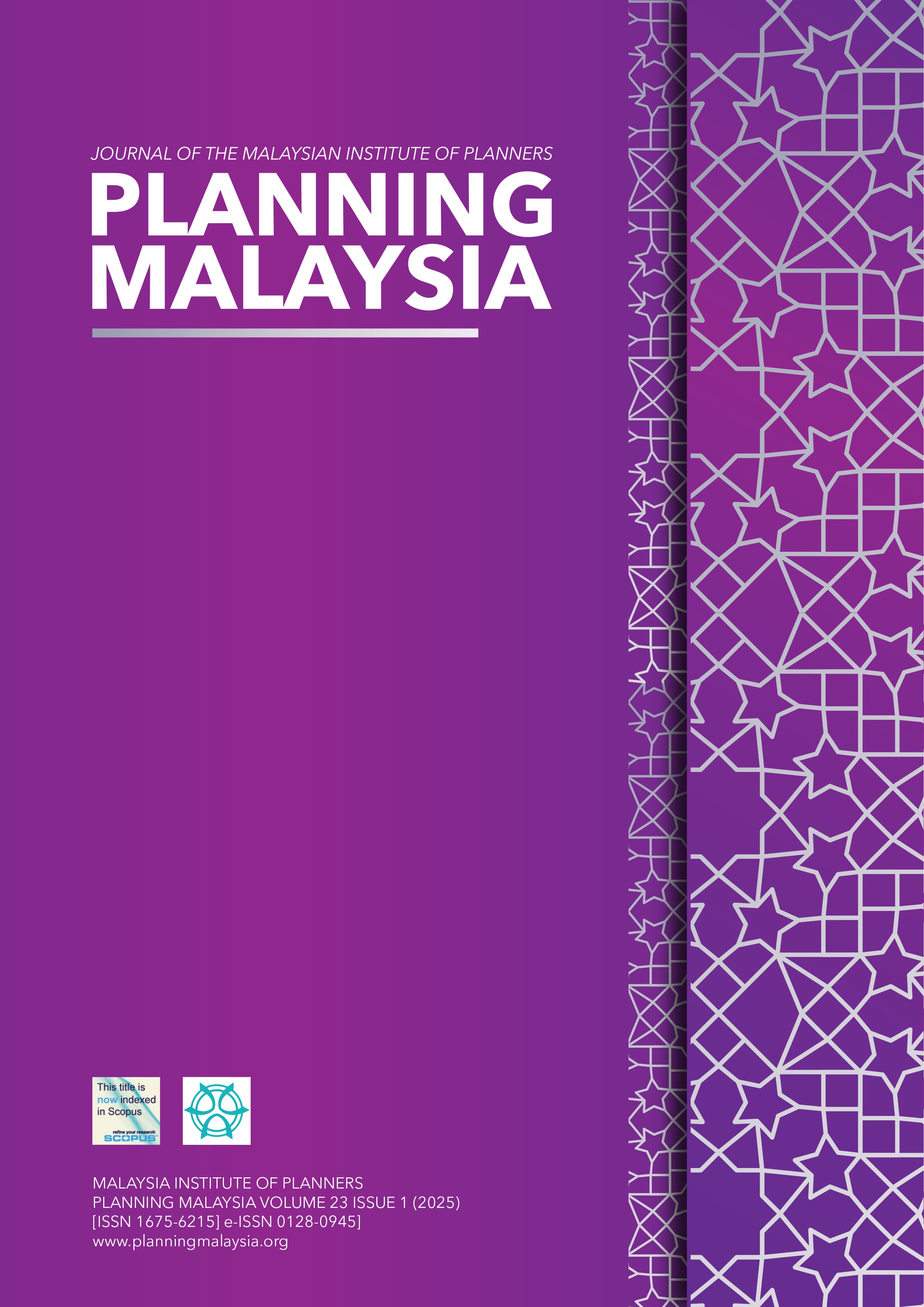GREEN SPACE EVALUATION OF SHAH ALAM LOW CARBON CITY, SELANGOR, MALAYSIA
DOI:
https://doi.org/10.21837/pm.v23i35.1668Keywords:
Green space, Low Carbon City, carbon reduction, development strategy, sustainable cityAbstract
This study examines Shah Alam's progress towards achieving its 2030 low-carbon city goal, focusing on the balance between rapid development, population growth, and carbon emissions. It emphasizes the necessity of a holistic approach to sustainable urban development that integrates societal needs with environmental concerns. The study aims to identify (i) the defining characteristics of green spaces in Shah Alam and (ii) the effectiveness of stakeholders' development strategies related to these green spaces. A qualitative methodology was adopted, utilizing six expert interviews conducted both face-to-face and online. Thematic analysis of these interviews revealed detailed insights into the interplay between green spaces and low-carbon urban development. A strong correlation was found between the attributes of green spaces and their carbon absorption capacity, influenced by factors such as area size, plant diversity, and absorption rates. Initiatives like the "Tree for Life" campaign have notably advanced the low-carbon city goals through strategic green space development. These collective efforts underscore the growing trend towards sustainable urban environments and highlight the critical role of comprehensive programs in enhancing green spaces to achieve low-carbon, sustainable cities.
Downloads
References
Alamah, M., Sakurah, J., & Siti Mazwin, K. (2015). Carbon Sequestration through Urban Green Reserve and Open Space. Planning Malaysia: Journal of the Malaysian Institute of Planners, 13, 101-122. DOI: https://doi.org/10.21837/pmjournal.v13.i5.142
Aram , F., García, E., Solgi, E., & Mansournia, S. (2019). Urban green space cooling effect in city. Heliyon, 5, 1-31. DOI: https://doi.org/10.1016/j.heliyon.2019.e01339
Bakhary, N. (2023). Semi- Structured Interview of Industry 4.0 for the SMEs in the Malaysian Construction Industry. Proceedings of the 22nd European Conference on Research Methodology in Business and Management, ECRM 202, (pp. 9-17). DOI: https://doi.org/10.34190/ecrm.22.1.1290
Gao, S., & Zhang, S. (2020). Urban planning for low-carbon sustainable development. Sustainable Computing: Informatics and Systems, 28, 1-7. DOI: https://doi.org/10.1016/j.suscom.2020.100398
Haas, W., Hassink, J., & Stuiver, M. (2021). The Role of Urban Green Space in Promoting Inclusion: Experiences From the Netherlands. Frontiers in Environmental Science, 1-11.
Haliza, A. (2020). Malaysia Commitment towards Low Carbon Cities. International Journal of Academic Research in Business & Social Sciences, 10(15), 253–266. DOI: https://doi.org/10.6007/IJARBSS/v10-i15/8247
Junainah , A., Mohd Johari, M., & Helmi Zulhaidi, M. (2019). The Many Benefits of Urban Green Spaces. CSID Journal of Infrastructure Development, 2(1), 103-116. DOI: https://doi.org/10.32783/csid-jid.v2i1.47
Malaysian Green Technology And Climate Change Corporation. (2024). MGTC. Retrieved from Shah Alam City Council the biggest winner at Malaysian Low Carbon City Awards 2023: Retrieved from https://www.mgtc.gov.my/2024/02/shah-alam-city-council-the-biggest-winner-at-malaysian-low-carbon-city-awards-2023/
MBSA. (2017). Draft Rancangan Tempatan Majlis Bandaraya Shah Alam 2035. Retrieved from https://fliphtml5.com/xgyik/tzqk/basic
Mohd Johari, M., Helmi Zulhaidi, M., & Junainah, A. (2019). Urban Green Space Degradation: An Experience of Kuala Lumpur City. Environmental Management and Sustainable Development, 8(1), 27-41. DOI: https://doi.org/10.5296/emsd.v8i1.13917
Nor Baizura, J., Yusfida Ayu, A., D. Ary Adriansyah, S., Nurul Shakila, K., & Na’asah, N. (2023). Determining Low Carbon City (LCC) Indicators for Governance at Local Government in Malaysia. International Journal on Sustainable Tropical Design Research and Practice, 16(2), 58-70. DOI: https://doi.org/10.47836/AC.16.2.PAPER07
Owen, T., Mohd Johari, M., Sreetheran, M., Kei, S., & Junainah, A. (2022). Green Infrastructure Transitional Management Sphere Analysis of Policies and Regulations in Kuala Lumpur, Malaysia. Planning Malaysia: Journal of the Malaysian Institute of Planners, 20(2), 61-73. DOI: https://doi.org/10.21837/pm.v20i21.1092
Siti Afiqah, M., Zakiah, P., Aisyah , A., & Fatiah, A. (2023). Comparative Analysis of Open Green Spaces Policies in Enhancing Urban Resilience to Climate Change through Small Urban Parks in Malaysia and Singapore. Chemical Engineering Transactions, 106, 211-216.
Urbanice Malaysia. (2021). Shah Alam Voluntary Local Review 2021. Retrieved from https://unhabitat.org/sites/default/files/2021/07/vlr_sdgs_shah_alam.pdf
Venter, Z., Hassani, A., Stange, E., Schneider, P., & Castell, N. (2024). Reassessing the role of urban green space in air pollution control. Environmental Sciences Earth, Atmospheric, and Planetary Sciences, 121(6), 1-9. DOI: https://doi.org/10.1073/pnas.2306200121
Wang, X., Wang, G., Chen, T., Zeng, Z., & Heng, C. K. (2023). Low-carbon city and its future research trends: A bibliometric analysis and systematic review. Sustainable Cities and Society, 1-27. DOI: https://doi.org/10.1016/j.scs.2022.104381
Wei, J., & Wenmei, K. (2019). A Review on the Low-Carbon City Study: Development and Trends. Chinese Journal of Urban and Environmental Studies, 7(2), 1-12.
Yusfida Ayu, A., Khalid, Z., Nor Baizura, J., Marlyana Azyyati, M., & Mohammad Yusup. (2023). An Exploration of Community Engagement and Participation in the Low Carbon City (LCC) Initiative: Case Study of Majlis Bandaraya Shah Alam. Planning Malaysia: Journal of the Malaysian Institute of Planners, 21(5), 357 – 372. DOI: https://doi.org/10.21837/pm.v21i29.1376
Zhao, D., Cai, J., Xu, Y., Liu, Y., & Yao, M. (2023). Carbon Sinks in Urban Public Green Spaces under Carbon Neutrality: A Bibliometric Analysis and Systematic Literature Review. Urban Forestry & Urban Greening, 86, 1-16 DOI: https://doi.org/10.1016/j.ufug.2023.128037
Downloads
Published
How to Cite
Issue
Section
License

This work is licensed under a Creative Commons Attribution-NonCommercial-NoDerivatives 3.0 Unported License.
Copyright & Creative Commons Licence
eISSN: 0128-0945 © Year. The Authors. Published for Malaysia Institute of Planners. This is an open-access article under the CC BY-NC-ND license.
The authors hold the copyright without restrictions and also retain publishing rights without restrictions.


